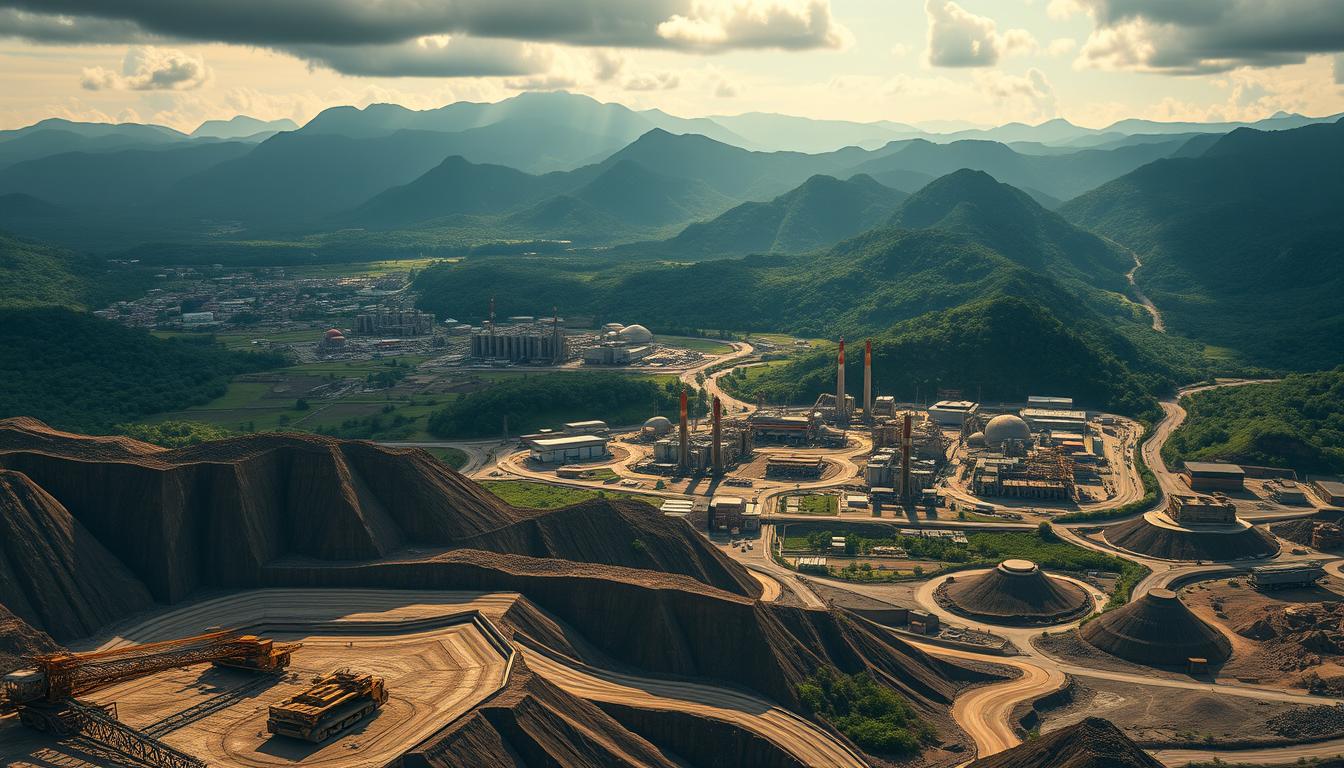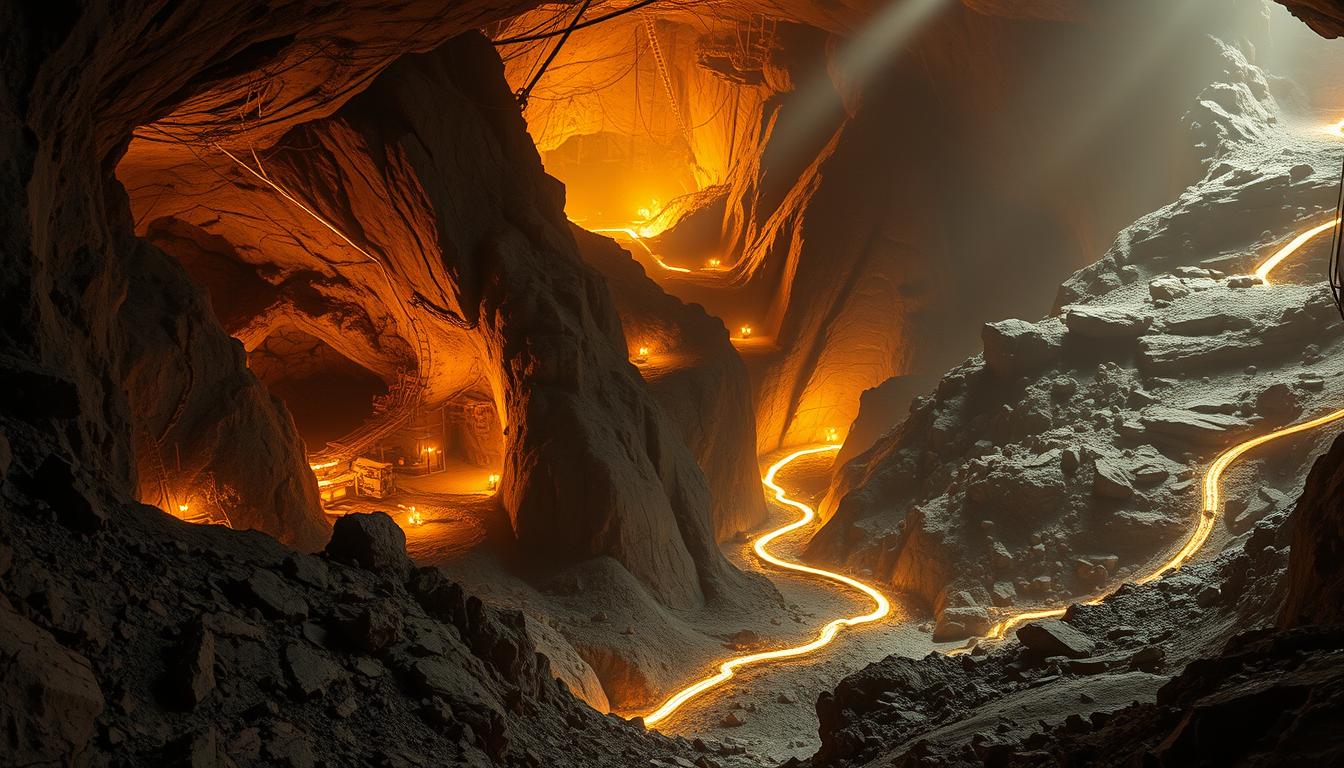For centuries, civilizations have relied on hidden treasures beneath their feet to fuel progress. Ancient societies built empires using metals mined from mountains, while modern economies depend on groundwater to sustain crops during droughts. But what separates regions that thrive from those stuck in poverty despite rich underground reserves?
Underground resources shape economies in surprising ways. Historical mining towns often became trade hubs, while communities with efficient irrigation systems weathered climate shocks. Early examples like Rome’s aqueducts show how sustainable extraction supported long-term growth. Today, nations balancing resource use with environmental safeguards create lasting advantages.
Government policies play a critical role. Strategic investments in extraction technology and fair labor practices help countries avoid the “resource curse” that plagues some regions. Modern geo-economic models emphasize knowledge-sharing between communities and industries to maximize value without ecological harm.
Key Takeaways
- Underground assets like minerals and water systems historically shaped trade routes and agricultural stability
- Effective management requires balancing extraction with environmental protections
- Government policies determine whether resources become engines of growth or sources of conflict
- Modern strategies avoid traditional financial instruments, focusing instead on sustainable reinvestment
- Historical case studies reveal patterns still relevant for today’s resource-dependent economies
From Mesopotamian irrigation to 21st-century lithium mining, the relationship between land and prosperity keeps evolving. This exploration uncovers how strategic decisions turn underground potential into measurable progress for communities and nations alike.
The Role of Subterranean Resources in Economic Development
Underground assets have silently shaped the rise and fall of civilizations throughout history. Ancient Mesopotamians built qanat irrigation systems to tap groundwater, transforming arid lands into fertile valleys. Similarly, Roman silver mines funded empire expansion while creating trade networks across Europe.
Historical Perspectives on Resource Extraction
Early methods prioritized immediate gains over sustainability. Miners in medieval Germany exhausted surface deposits within decades, forcing deeper excavations. This sparked innovations like water-powered pumps – precursors to modern extraction tech. Regions with accessible metals often became economic hubs, but overuse led to environmental degradation and social conflicts.
Modern Approaches to Sustainable Management
Today’s strategies focus on balancing productivity with preservation. Precision irrigation systems now reduce agricultural water waste by 35% compared to traditional methods. Governments implement policies like aquifer recharge programs and mineral royalties that fund local green infrastructure projects.
California’s Central Valley demonstrates this shift. Satellite monitoring and regulated pumping cut groundwater depletion rates by 22% since 2014 while maintaining crop yields. Such models prove environmental safeguards can coexist with economic growth when supported by adaptive policies and community engagement.
How Nations Develop Wealth from Below Ground
Regional disparities in resource utilization reveal patterns of prosperity and missed opportunities. Areas rich in minerals or groundwater often follow divergent paths based on governance frameworks and reinvestment strategies.
Comparative Regional Analysis and Economic Trends
Medieval Saxony’s silver mines generated 40% of Europe’s currency metals, creating specialized labor markets that evolved into financial hubs. The wealth generated from these mines not only facilitated trade across Europe but also attracted skilled workers and merchants, fostering an environment ripe for economic innovation and cultural exchange. Meanwhile, Cornwall’s tin deposits fueled initial growth but left communities impoverished when extraction methods became obsolete.
As demand for tin declined and more efficient sources were discovered elsewhere, the local economy struggled to adapt, leading to a decline in population and investment. This stark contrast highlights the importance of sustainable practices and adaptive strategies in resource management, as regions that failed to diversify their economies faced significant long-term challenges.
Modern contrasts persist. Chile’s lithium reserves now power 60% of global batteries through strategic technology partnerships, while Bolivia struggles with untapped reserves due to policy stagnation. These cases highlight how historical capital allocation shapes long-term outcomes.
Investment Strategies and Policy Implications
Norway’s sovereign wealth fund demonstrates effective resource revenue management, channeling oil profits into renewable energy projects. Key policy elements include:
- Mandatory profit-sharing agreements with local communities
- Gradual transition plans for post-extraction economies
- Cross-sector knowledge transfer initiatives
South Africa’s platinum belt shows mixed results. While mining contributes 12% of GDP, limited infrastructure investments perpetuate regional inequality. Successful models prioritize sustainable frameworks over short-term gains, proving that strategic governance determines whether underground assets become engines of growth or sources of conflict.
Subterranean Wealth and Its Impact on Agricultural Productivity
Access to underground water reserves has become a decisive factor in global food security. Communities leveraging these resources sustainably witness transformative improvements in crop resilience and economic stability. This access not only enhances agricultural output but also plays a critical role in supporting local economies, especially in regions prone to drought and climate variability.
Effective management turns arid lands into productive hubs while mitigating climate risks. By implementing advanced irrigation techniques and promoting conservation practices, these communities can ensure a steady supply of water for crops, thereby reducing vulnerability to food shortages and fostering long-term sustainability.

Groundwater Management and Irrigation Efficiency
Solar-powered pumps now irrigate 15 million acres worldwide, reducing energy costs by 65% compared to diesel alternatives. In India’s Punjab region, precision watering systems boosted wheat yields by 28% while conserving 40% more groundwater. Such innovations directly combat child stunting rates by stabilizing food supplies – studies show a 12% reduction in malnutrition where sustainable irrigation practices dominate.
Technological Advancements in Extraction Methods
Smart sensors and AI-driven models optimize water extraction, preventing aquifer depletion. California’s Central Valley reduced groundwater overdraft by 32% using real-time monitoring systems. These tools enable farmers to allocate water precisely, matching crop needs without waste.
Government policies accelerate adoption. Kenya’s subsidy programs increased solar pump installations by 300% since 2020, creating new export markets for drought-resistant crops. As extraction technologies evolve, they redefine how regions convert underground assets into measurable prosperity.
Mining History and the Emergence of Capitalist Corporations
Medieval mining operations reshaped Europe’s economic landscape in ways still visible today. Silver-rich regions like the Alps and Carpathians became laboratories for corporate innovation, where early capitalist structures first took root. These ventures combined geological luck with human ingenuity to create lasting systems of wealth generation.

From Shovels to Shareholders
Twelfth-century silver mines in Saxony pioneered profit-sharing models that redistributed gains across social classes. Miners received wages tied to output, while investors funded deeper excavations. This system birthed joint-stock companies – precursors to modern corporations. As historian Jeannette Graulau notes, “Medieval mining charters codified rights and risks in ways that mirrored later capitalist frameworks.”
Geographical advantages determined success. The Tuscan Apennines’ mercury deposits enabled efficient silver refining, while Sardinia’s coastal mines streamlined trade. Regions with accessible ore and navigable waterways dominated early resource economies.
Legacy of Extraction
Technological leaps drove change. Water-powered pumps from the Harz Mountains increased extraction rates fivefold by 1350. Administrative reforms followed, with standardized weights and mining codes reducing conflicts. These advancements laid groundwork for industrial-era factories and supply chains.
Three key innovations emerged:
- Legal charters protecting investor rights
- Specialized labor roles increasing productivity
- Infrastructure networks connecting mines to markets
Modern economies still grapple with medieval mining’s lessons. Balancing extraction with equitable growth remains central to sustainable development, proving that underground resources shape societies long after mines close.
Geo-Economic Insights: Production, Policy, and Potential
Three critical transitions determine how countries convert raw materials into lasting wealth. These shifts reshape labor markets, trade relationships, and technological capabilities over generations. Successful navigation requires strategic planning and adaptive governance.

The Three Stages of Economic Development
Nations typically progress through distinct phases:
| Stage | Focus | Key Challenge |
|---|---|---|
| Extraction | Harvesting natural resources | Environmental preservation |
| Manufacturing | Value-added production | Workforce upskilling |
| Information | Knowledge-based services | Preventing brain drain |
Chile’s lithium industry demonstrates this progression. From mining raw ore in the 1990s to producing battery components today, the economy added $2.8 billion in annual value through manufacturing upgrades.
Government Policies and Trade Implications
Strategic subsidies accelerate transitions between stages. Norway redirected 78% of oil revenues into renewable energy investment, creating 45,000 green tech jobs. Conversely, high tariffs on mineral exports often hinder growth – Zambia’s copper restrictions reduced mining productivity by 17% over five years.
Education systems prove vital for retaining talent. Regions with scalable vocational training programs retain 34% more skilled workers than extraction-focused areas. As economist Mariana Campos observes, “Policies bridging raw materials and human capital build resilient economies that outlive finite resources.”
Sustainable Practices and the Future Outlook for Underground Wealth
Global demand for underground assets now clashes with urgent ecological needs, forcing nations to rethink development models. Recent studies show groundwater overuse threatens 20% of the world’s agricultural zones, while mineral extraction degrades 380,000 square kilometers annually. Forward-thinking regions are proving these challenges can spark innovation rather than crisis.
Balancing Resource Extraction with Environmental Integrity
Australia’s Great Artesian Basin rehabilitation program demonstrates this balance. By capping unused wells and installing smart meters, the government reduced water waste by 52% while maintaining livestock productivity. Key strategies include:
- Real-time monitoring of aquifer levels
- Tax incentives for renewable-powered mining equipment
- Community-led land restoration initiatives
Innovation in Resource Management and Energy Transition
Morocco’s solar-powered desalination plants now replenish groundwater with 600 million cubic meters annually – enough for 1.2 million farms. Germany’s Ruhr Valley, once a coal hub, generates 40% of its energy from repurposed mine shafts storing geothermal heat. These shifts highlight how investment in green tech transforms former resource economies.
Future progress hinges on policy agility. Chile’s lithium extraction reforms mandate 30% recycled water usage, cutting environmental impacts by half. As technologies evolve, underground wealth could fuel both economic stability and ecological healing – if regions prioritize long-term vision over short-term gains.
Conclusion
Transforming underground potential into national wealth demands more than mere extraction. Historical patterns reveal that societies thriving on subterranean assets combine innovation with lessons from past successes and failures. Medieval mining hubs laid groundwork for modern corporate structures, proving that resource management shapes economic legacies.
Today’s economy requires balancing productivity with preservation. Regions adopting solar-powered irrigation or AI-driven water systems demonstrate how technology converts scarcity into abundance. These advances stabilize food supplies while protecting aquifers – critical for agricultural resilience in drought-prone areas.
Government policies remain pivotal. Chile’s lithium reforms and Norway’s energy transitions show strategic frameworks turn finite assets into lasting value. Effective models prioritize community partnerships, adaptive regulations, and reinvestment in green infrastructure.
The future belongs to regions merging historical wisdom with sustainable practices. By aligning extraction efficiency with ecological safeguards, nations can build prosperous, equitable economies. Policymakers must act decisively – underground wealth only becomes transformative when managed as a bridge between past and future.















Post Comment